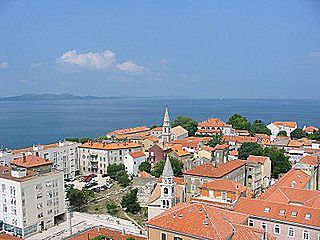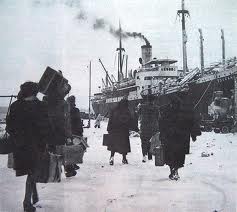Biography
Born and growth up in Zadar (then official Zara), [2] from the old noble Dalmatian family of de' Vidovich, Counts Capocesto e Ragosniza; he is a close cousin of Ottavio Missoni. He left Zadar for the exile at the beginning of the massive bombing of the city made by Allies in 1943. He moved to Trieste where he was general secretary of the board of students movement which assumed the responsibility of convening the riots of 5 and 6 November 1953 in support of the return of Trieste to Italy, that time occupied by the Anglo-American Allied Military Government.
Six Italians died during the fighting and there were a total of 153 wounded. The following year there was the reunification of Trieste to Italy. According with a de' Vidovic proposal, supported by the Lega nazionale di Trieste, the Government Berlusconi II awarded the National civil gold medal to the dead fighters specifying that were decisive for the return of Trieste to its motherland.
While he was student at University of Trieste, de' Vidovich was editor of the newspaper La zona franca ("The Free Zone") which will result decisive for the creation of a national economic free zone of Trieste. In 1968 he became secretary of the national labor union Cisnal, today Unione Generale Lavoro (UGL), in Trieste.
He founded and directed La Città, an information magazine. Member of the municipal council of Trieste for more than ten years, he was also elected as city councilor in the town of Duino-Aurisina where he fought for the touristic development of Sistiana.
In 1972 de' Vidovich was elected to the Italian Chamber of Deputies for the Trieste electoral district, and was appointed secretary of the parliamentary group of the post-fascist Italian Social Movement. [1]
He was also mayor of the Free Comune of Zara in Exile.
In 1999 he was appointed as president of the Federation of Exiles from Istria, Fiume and Dalmatia. As president of the Rustia-Traine Foundation he participates actively to the creation of the Italian communities in Dalmatia: Zadar, Split, Hvar and Kotor. He also promoted courses of Italian language and culture in Dalmatia, and, in 2004, he founded the Centro di Ricerche Culturali Dalmate (Dalmatian Cultural Research Centre) in Split of which de' Vidovich is still chairman. The center promotes the publication - in collaboration with the Veneto Region - of numerous books on the cultural heritage of Dalmatia and Venice.

Dalmatia is one of the four historical regions of Croatia, alongside Central Croatia, Slavonia and Istria, located on the east shore of the Adriatic Sea in Croatia.

Italian irredentism was a political movement during the late 19th and early 20th centuries in Italy with irredentist goals which promoted the unification of geographic areas in which indigenous peoples were considered to be ethnic Italians. At the beginning, the movement promoted the annexation to Italy of territories where Italians formed the absolute majority of the population, but retained by the Austrian Empire after the Third Italian War of Independence in 1866.

The Kingdom of Dalmatia was a crown land of the Austrian Empire (1815–1867) and the Cisleithanian half of Austria-Hungary (1867–1918). It encompassed the entirety of the region of Dalmatia, with its capital at Zadar.
The History of Dalmatia concerns the history of the area that covers eastern coast of the Adriatic Sea and its inland regions, from the 2nd century BC up to the present day. The region was populated by Illyrian tribes around 1,000 B.C, including the Delmatae, who formed a kingdom and for whom the province is named. Later it was conquered by Rome, thus becoming the province of Dalmatia, part of the Roman Empire. Dalmatia was ravaged by barbaric tribes in the beginning of the 4th century.

The Istrian–Dalmatian exodus was the post-World War II exodus and departure of local ethnic Italians as well as ethnic Slovenes and Croats from Yugoslavia. The emigrants, who had lived in the now Yugoslav territories of the Julian March, Kvarner and Dalmatia, largely went to Italy, but some joined the Italian diaspora in the Americas, Australia and South Africa. These regions were ethnically mixed, with long-established historic Croatian, Italian, and Slovene communities. After World War I, the Kingdom of Italy annexed Istria, Kvarner, the Julian March and parts of Dalmatia including the city of Zadar. At the end of World War II, under the Allies' Treaty of Peace with Italy, the former Italian territories in Istria, Kvarner, the Julian March and Dalmatia were assigned to now Communist-helmed Federal Yugoslavia, except for the Province of Trieste. The former territories absorbed into Yugoslavia are part of present-day Croatia and Slovenia.

Dalmatian Italians are the historical Italian national minority living in the region of Dalmatia, now part of Croatia and Montenegro.

The Italian language is an official minority language in Croatia, with many schools and public announcements published in both languages. Croatia's proximity and cultural connections to Italy have led to a relatively large presence of Italians in Croatia.
Parliamentary elections were held in Kingdom of Dalmatia for the newly formed Dalmatian parliament in 1861.

The Diet of Dalmatia was the regional assembly of the Kingdom of Dalmatia within the Austro-Hungarian Empire. It was founded in Zadar in 1861 and last convened in 1912, before being formally dissolved in 1918, with the demise of the Empire.

The Governorate of Dalmatia was an administrative division of the Kingdom of Italy, established in 1941, following the military conquest of Yugoslavian Dalmatia by General Vittorio Ambrosio, during World War II. It had the provisional purpose of progressively importing Italian national legislation in Dalmatia in place of the previous one, thus fully integrating it into the Kingdom of Italy.
The Autonomist Party was an Italian-Dalmatianist political party in the Dalmatian political scene, that existed for around 70 years of the 19th century and until World War I. Its goal was to maintain the autonomy of the Kingdom of Dalmatia within the Austro-Hungarian Empire, as opposed to the unification with the Kingdom of Croatia-Slavonia. The Autonomist Party has been accused of secretly having been a pro-Italian movement due to their defense of the rights of ethnic Italians in Dalmatia. The Autonomist Party did not claim to be an Italian movement, and indicated that it sympathized with a sense of heterogeneity amongst Dalmatians in opposition to ethnic nationalism. In the 1861 elections, the Autonomists won twenty-seven seats in Dalmatia, while Dalmatia's Croatian nationalist movement, the National Party, won only fourteen seats. This number rapidly decreased: already in 1870 autonomists lost their majority in the Diet, while in 1908 they won just 6 out of 43 seats.

The House of Bona, or Bunić, is a noble family long established in the city of Dubrovnik.

The House of Cerva or Crijević was a Ragusan noble family from Ragusa, which held noble titles in the Republic of Ragusa, and in the Austrian and Austro-Hungarian empires. Descendants of the family live in Austria and Italy.

The House of Bobali or Babalio was a noble family of the Republic of Ragusa.

The House of Buća was a noble Serbian family that served the Republic of Ragusa, and one of the most important families to come out of Kotor. A cadet branch was admitted to the nobility of the Republic of Ragusa, another branch moved instead to Šibenik.

Italians of Croatia are an autochthonous historical national minority recognized by the Constitution of Croatia. As such, they elect a special representative to the Croatian Parliament. There is the Italian Union of Croatia and Slovenia, which is a Croatian-Slovenian joint organization with its main site in Rijeka, Croatia and its secondary site in Koper, Slovenia.

Italian irredentism in Dalmatia was the political movement supporting the unification to Italy, during the 19th and 20th centuries, of Adriatic Dalmatia.

The Province of Zara was a province of the Kingdom of Italy, officially from 1918 to 1947. In 1941 it was enlarged and made part of the Italian Governorate of Dalmatia, during World War II, until 1943.

Lucio Toth was a Dalmatian Italian politician.
Athos Bartolucci was an Italian Fascist politician and journalist, who served as federal secretary of the National Fascist Party in Dalmatia from 1934 to 1942 and as Civilian Commissioner for occupied Dalmatia during World War II.
















